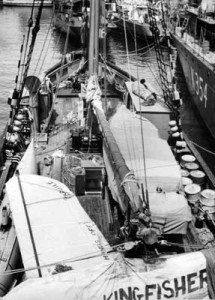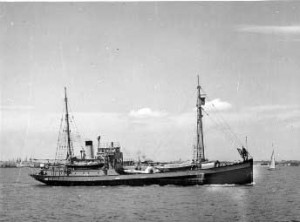
Wyatt Earp was used by Ellsworth on four Antarctic expeditions from 1933 to 1939 as a base ship for his aircraft. In February 1939 she was purchased from Ellsworth by the Commonwealth Government and handed over to the Royal Australian Navy.
The Royal Australian Navy intended using Wyatt Earp as a Fleet Auxiliary (Ammunition and Store Carrier). On 8 September 1939 it was decided to rename her Boomerang. This name, however, was rejected when it was found that a vessel of that name was already registered in Australia. In the event on 25 October 1939 she was named Wongala, an aboriginal word meaning boomerang.
Wongala began service as a Royal Australian Fleet Auxiliary on 14 November 1939 when she departed Sydney for Darwin with a cargo of stores. This was Wongala’s only voyage as a Fleet Auxiliary. On return to Sydney on 11 January 1940 she was laid up pending a decision on her future employment.

Wongala served at Port Adelaide until the Examination Service was suspended at that port in 1943. From November 1943 to March 1944 she served as Guard Ship at Whyalla, also being employed in patrolling the Whyalla, Port Pirie and Wallaroo areas and as Mother Ship to the Naval Auxiliary Patrol. On 26 March 1944 Wongala departed Whyalla for Port Adelaide where she arrived the following day to await disposal. On 19 July 1944 she paid off at Port Adelaide.
Before a decision on her disposal was made the Minister for the Navy received a request from the South Australian Branch of the Boy Scouts Association on 3 March 1945, that the ship be made available for Sea Cadet training.
In February 1947 the Association was notified by the Department of the Navy that the Commonwealth Government was considering renewing Antarctic exploration and the suitability of Wongala to participate. The Association was therefore requested to return the vessel to the Resident Naval Officer in Adelaide to be slipped and surveyed. After examination, Navy reported to the Department of External Affairs that the vessel was basically sound. Government approval was then given to her conversion for Antarctic exploration.
While this work was being carried out, the Naval Board decided on 16 July 1947 that in view of her impending voyage to the Antarctic, and since it was under the name of Wyatt Earp that she had achieved international fame for her previous exploration work there, that Wongala was to be renamed Wyatt Earp. The use of her former name became effective as from that date. She recommissioned on 17 November 1947 at Port Adelaide under the command of CMDR Karl E Oom OBE RAN.
Prior to her departure from Adelaide, Sir Douglas and Lady Mawson visited Wyatt Earp on 9 December and on 11 December, the pupils and staff of Ethelton School presented the ship with a Blue Ensign. On 13 December she sailed for Melbourne where she arrived on 17 December.
Defects which had developed on passage from Adelaide to Melbourne were made good by 19 December so that Wyatt Earp was able to cast off from Nelson Pier, Williamstown, on that day and proceed to Hobart. A strong gale was experienced on the following afternoon, which, due to her fully loaded condition, made the ship’s movement extremely violent and uncomfortable until the gale abated near midnight.
On 22 December the weather again deteriorated with south west winds accompanied by rain squalls and poor visibility which improved as the ship approached Hobart. She secured alongside Elizabeth Street Pier and refitting began at once. This was completed by 24 December but defects developed during trials delayed her departure from Hobart until 26 December when she proceeded to sea on passage to the Antarctic.
Because of damage by heavy seas, and in particular because her main engines settled on the engine bed, she was recalled by the Naval Board on 1 January 1948. On 7 January she secured to Station Pier, Port Melbourne. On the following day the aircraft and perishable stores were landed and Wyatt Earp entered the Graving Dock at Williamstown for repairs. When these were effected, Wyatt Earp sailed from Nelson Pier on 8 February and at midnight, when west of Cape Wickham, set course for Commonwealth Bay, Adelie Land.
Under favourable conditions, good progress was made until 13 February. By that date she was in position 53º16’S, 144º10’E. Gale force westerly winds which began on 12 February caused her to alter course to west south west and reduce speed the following day. Course was resumed on 14 February when the wind backed towards south.
By 18 February, through continuous gales, Wyatt Earp had reached 65º26’S, 143º35’E. There was a slight improvement in conditions and visibility and the first icebergs were seen.
On 19 February a freshening wind and thickening scattered pack ice compelled the ship to retreat. By the time she reached clear water the wind had reached hurricane force, compelling her to heave to. When the wind abated to gale force the next day, course was resumed southward.
Heavy, dense pack ice frustrated attempts to reach Adelie Land so that on 14 March after endeavouring to penetrate the ice and turning back to avoid becoming trapped on several occasions, course was finally set northward for Macquarie Island. In the previous three weeks, several islands had been surveyed and errors in their charted positions corrected.
Wyatt Earp came to anchor at Buckles Bay, Macquarie Island on 20 March, and found that LST 3501 (later named HMAS Labuan), which had sailed from Melbourne on 28 February 1948 with a party of scientists on board, was already at anchor and had a landing party ashore setting up a Station.
The two ships remained in company until 24 March by which time the scientific party was well established ashore for a stay of one year. Wyatt Earp departed from Macquarie Island for Melbourne on 24 March and LST 3501 left for Melbourne, via Hobart, the following day.
Owing to favourable weather conditions from 25 March onwards, Wyatt Earp was able to reach Port Melbourne and tie up alongside Station Pier on 1 April, 12 hours ahead of schedule.
On her return it was decided that she would not be used for further Antarctic voyages. She finally paid off at Melbourne on 30 June 1948 and was sold to the Arga Shipping Company (Victoria), delivery being effected on 9 November 1951. Under her former name of Wongala, the Arga Company used her for tramping between mainland Australian and Tasmanian ports.
In 1956 she was bought by the Ulverstone Shipping Company who renamed her Natone, presumably after the potato growing district of Natone near Ulverstone, Tasmania. After some 18 months trading in Tasmanian waters she began service between Queensland ports with an occasional voyage south to Victoria.
In January 1959, en route from Cairns to Brisbane, she encountered two severe storms. She successfully weathered the first but during the second sprang a leak. The pumps could not cope with the intake of water which soon flooded the engine room. Sails were rigged and she managed to reach Rainbow Bay. Then the moorings failed to hold and she began to drift.
During the night of 23/24 January 1959, she ran aground near Mudlow Rocks some six miles north of Double Island Point Lighthouse. Her crew of six Australians and 12 Papua New Guineans reached the shore using her hatch covers as rafts.
Further Reading: The Antarctic Voyage of HMAS Wyatt Earp by Law, Phillip. Allen & Unwin, St Leonards 1995
HMAS Wyatt Earp
Type Antarctic Exploration Vessel
Builder Bolsönes Shipyard, Molde, Norway
Commissioned 17 November 1947
Decommissioned January 1959
Fate Ran aground on 23/24 January 1959
Dimensions & Displacement
Displacement 402 tons
Length 135 feet 7 inches
Beam 29 feet 2 inches
Draught 14 feet 4 inches
Performance
Speed 8.5 knots
Propulsion
Machinery Semi-diesel engines, single screw
Horsepower 400
Armament
Guns Machine guns
Other Armament 1 x Oerlikon



